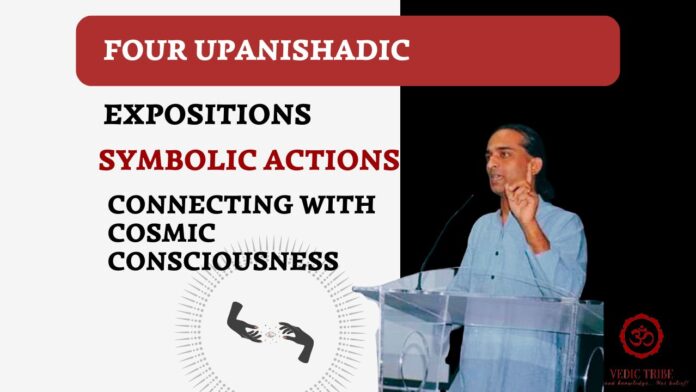Symbolic Representation of Connecting with Cosmic Consciousness
In the previous article, we discussed symbolic forms in Upanishads. In this article, we will discuss symbolic actions in Upanishads.
One of the central themes of the Upanishads is the idea of connecting with cosmic consciousness through “enquiry” (not belief). The texts employ various symbols and metaphors to represent this process.
“Enquiry” is the central theme in the Upanishads. It is through the process of questioning, contemplation, and self-inquiry that the Upanishads seek to unravel the mysteries of existence. This emphasis on inquiry distinguishes the Upanishads from Abrahamic traditions, which primarily teach belief and faith, where questioning the religious text is considered blasphemy.
The process of “enquiry” in Upanishads take various forms of actions. In Katha Upanishad, the five year old boy Nachiketa travels to the adobe of Yama – the deity of death. Nachiketa’s action of “journey” symbolizes the spiritual path, a journey into the unknown; because “death” is one of the mysterious phenomena. This action also represents the confrontation with one’s mortality and the fear of death
The Symbolism of Meditation
Meditation in Vedic tradition: Meditation, or Dhyana, is a cornerstone practice in the Upanishadic enquiry. It is a key tool for unravelling the mysteries of existence and attaining spiritual enlightenment. The Upanishads emphasize direct experience over intellectual understanding and the action of meditation provides a means to directly enquire the experience of physical limitations and divinity within.
Meditation in other traditions: Buddhist meditation emphasizes the impermanent nature of all phenomena and contemplation of “ultimate nothingness” (shunya). Western meditation technique overly emphasizes the technique itself, rather than the underlying spiritual principles. This has led to a mechanical approach to meditation, where the focus is on achieving a certain state of mind, rather than a genuine spiritual practice. However, due to over-simplification and lack of inquisitiveness, these meditation techniques have gained popularity among lay people.
In Vedic tradition, however, meditation is neither focus on nothingness nor specializing a technique. Rather it symbolizes the mental action of an enquiry into the deep burning fundamental questions inside of all of us.
Other Symbolic Representations
Beyond meditation, the Upanishads employ other symbols to represent the process of connecting with Brahman:
The Journey: The journey of a seeker is often symbolized by a pilgrimage or a spiritual quest (E.g. journey of Nachiketa in Katha Upanishad)
The husbandry: In Chandogya Upanishad, Sage Gauthama asks his new student Sathyakama to raise cattle and come back after they have multiplied. In this process, Sathyakama receives divine knowledge from different animals. This is a metaphor to understand that the primordial knowledge is ubiquitous and any living creature can be a medium to receive it.
The shooting of arrow: The Mundaka Upanishad uses the bow and arrow to illustrate how meditation, self-reflection, and introspection can help to know the Atman and Brahman.
The symbolic actions specified in Upanishads help you to embark on a journey of spiritual inquiry and encourages you to do introspection, leading to a deeper understanding of your own thoughts, emotions, and experiences.
Key take aways for you:
Develop inquisitiveness: Though questions on fundamental nature of existence are burning within you and every one of us. Instead of dousing this fire, take action to develop your inquisitiveness. You can start by meditating upon the questions asked in Upanishads. E.g. Kena Upanishad starts with the question “which power makes the mind wander away towards the things it desires”?
Contemplate upon the Upanishadic answers: Upanishadic answer should be understood in spirit and contemplated upon.
Adopt metaphoric actions: For instance meditate upon Mundaka Upanishad by visualizing bow and arrow to focus your mind towards the spiritual enquiry.
But remember:
Symbolism: Actions like meditation are just symbols. The actual process is “enquiry” and this can take place via many other actions. E.g. learning etymology to decipher the meaning of Upanishadic teachings.
Continue the enquiry: Avoid accepting bookish teachings at face value. Instead enquire further and question your own understanding.
In the next article, we will discuss the fourth exposition – “Symbolic stories for eternal values”.
Madhwesh K
Vedic Tribe

